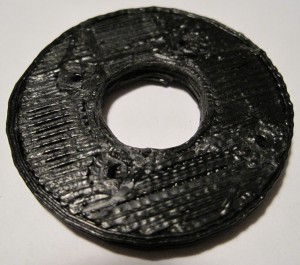Sometimes when using the ReplicatorG control panel I accidentally hit Z- instead of Z+ to adjust the stage height. As you might imagine, this causes problems. At best, I end up with the Z stage out of whack. At worst, the hot and extruding print head slams into the build platform or model and knocks the Z stage out of whack.
Two possible upgrades would be:
- A simple bubble level for the build platform and/or Z stage to make it easy to verify the surface is level. I would imagine bubble levels are relatively cheap.
- A bracket that fits around the lower section of the Z axis rods, which would prevent the Z stage from descending below a particular level. It could be as simple as a little plastic nub that is bolted to the inside of the ‘bot that prevents the stage from being lowered. Four of them would probably work fine. OR, you could put an extra nut on each Z axis below the nut that supports the Z stage. Someone could then design a little plastic widget that would fit on top of that extra nut and have a prong that sticks up – preventing the Z axis from lowering further.


